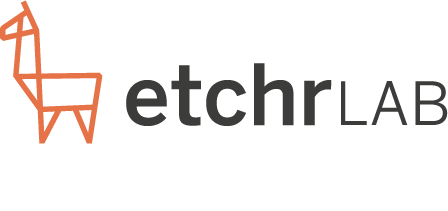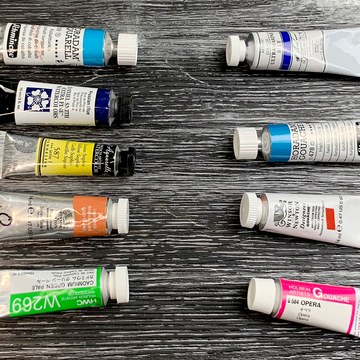If you are interested in watercolour, you might, sooner or later, come across gouache.
I remember gouache mostly from when I was a kid, it was the non-toxic paint that we could use with our hands directly on the paper
…So what is this tubed professional gouache, or this one called designer’s gouache? How does it compare to watercolour?
Watercolour and gouache have many characteristics in common. The main one is that they both use a water-soluble binder which makes them rewettable.
The better quality binder is gum arabic but sometimes, very inexpensive gouache paints will use dextrin instead. In both cases, you can dilute the colour with water to make it lighter.
They will use the same pigments for the colour and often the same extra wetting agents or preserving agents, such as glycerine or honey.
Gouache is fully matte when dry. Watercolour is mostly matte as well, though some brands and formulations might get a bit of a sheen when the colour is laid down very concentrated.

The two mediums also have a few elements that differ.
The main appeal of gouache is its increased opacity. While opacity is generally a consequence of the pigment used, gouache will use an extra inert ingredient to increase opacity of the colour.
This ingredient is a normal part of the gouache recipe and can be something like kaolin clay or lithopone.
In gouache, the opacity can also be a result of including more pigment in the formula, at the expense of actually binding that extra pigment to the paper. Some gouaches will rub-off or transfer a bit even when dry.
Watercolour is often about the transparency and glow of the colours. It allows for a lot of layering and lets us build up colour intensity gradually.
With this medium, it’s important to plan the image around which parts we want to keep white or very light. It is possible to lift off some of the watercolour paint, depending on the pigment, but it’ll never be as bright as the paper was.

Keeping the white of the paper as the light.
Gouache, with its opaque quality, is more forgiving. It allows for corrections, since the layered paints don’t have much transparency.
It’s much easier to paint light over dark, since we can use the opaque white paint (on its own, or tinted with another colour). This feature comes with a few considerations to keep in mind.
New to mixing colours? Check out this article on colour theory to get you started!
When layering gouache, we have to be careful when working the paint so we don’t reactivate too much of the underneath layers. It’s easy to end up with colours bleeding through.
Also, gouache has the potential to crack on the paper if it has been painted thickly and stored for a long time. It’s not a big concern, but something to keep in mind when putting gouache paintings in storage.
There’s another difference to note between gouache and watercolour. While the latter is generally easy to pour in a palette and let dry, gouache is more temperamental.
The tubed paints tend to dry crackly and don’t hold onto palettes well. It ends up as a mess of dry paint pieces the moment we handle the palette roughly.
Another option is to try to keep the gouache in a wet palette but that’s quite temporary too, as the paint can easily grow mould if kept wet in a closed container for too long.
Gouache is best stored in the tubes, it really doesn’t work well as a “dry” palette.
What we call “designer gouache” is professional-level gouache that was used frequently by designers, illustrators and commercial artists. This paint was intended for making art that would then be processed for printing.
The original painting would be discarded once this was accomplished. It was meant to be a temporary thing and as such, a strong focus was put on the colours themselves, rather than their lasting capabilities.
A consequence of this is that many gouache colours use fugitive pigments.
Is there an easy way to travel with gouache and not have to carry a dozen tubes around?
A good in-between is to curate a good palette of watercolour paints and carry a tube of titanium white gouache along.
A single tube of paint is convenient and the white is truly better fresh rather than dried out. To create gouache-like colours, we just have to mix them with our white.
The darker colours are gonna be from the watercolours alone, so they will be as transparent as their pigments.
However, it’s possible to build beautiful light areas with the tinted white gouache. It’s also a good way to “test the waters” with gouache, to see if the opacity is something that you want to pursue further.

Watercolour and gouache.
Gouache must not be confused with acrylic gouache. The former is made with a rewettable binder, which means that the substance that attaches the pigment to the paper will reactivate with water, even after it has dried.
Acrylic gouache uses an acrylic binder, which dries to a plastic and cannot be rewet once it’s dry. It would’ve been more accurate to name it “matte acrylic paint”, because that’s exactly what it is.
So, is gouache better? Is watercolour better? The answer to that is a personal one, as we all paint our own way. And it’s possible to mix and match, too. We can use watercolour along with gouache.
Did these mediums spark your interest? If they did, you can check out our Introduction to Watercolour course, as well as our Introduction to Gouache course for a deeper dive.
If the rewettability of these two paints on the paper is an issue, then matte acrylic might be the best option to get the feel of gouache but not the messiness.
Eve Bolt is a French-Canadian artist and YouTuber living in Montreal, Canada. Her favorite tools are watercolor and inks. She really likes cats.


